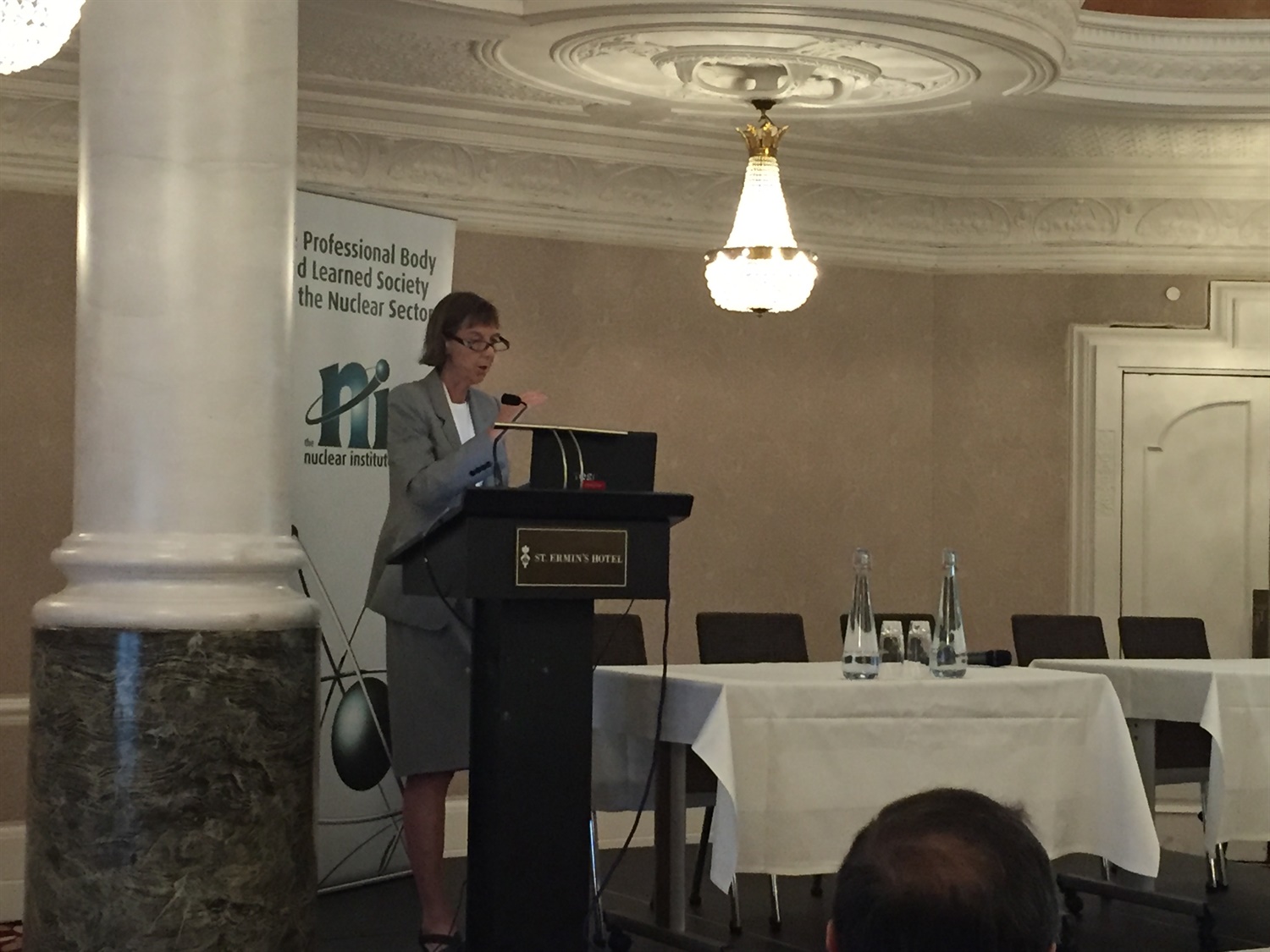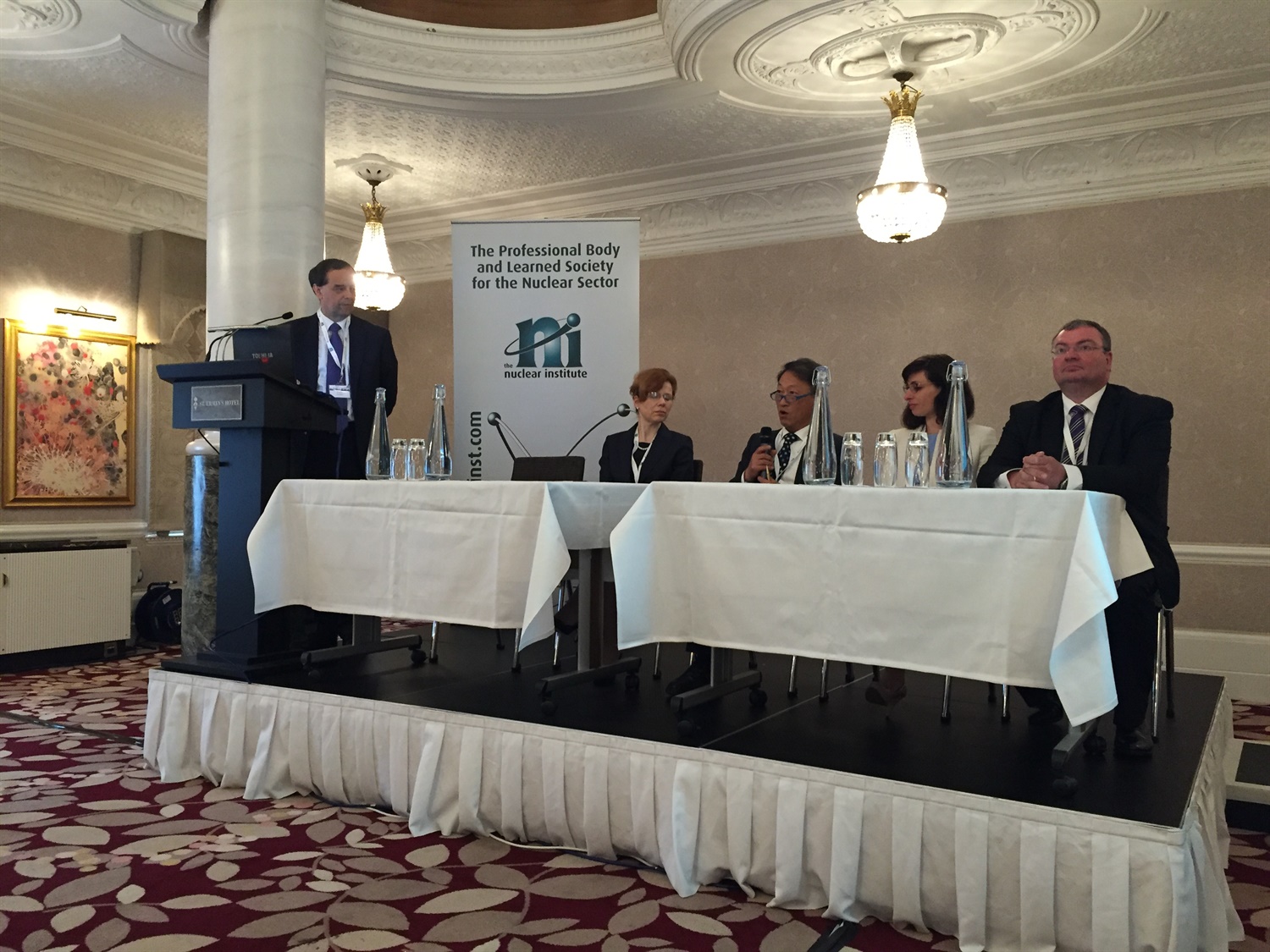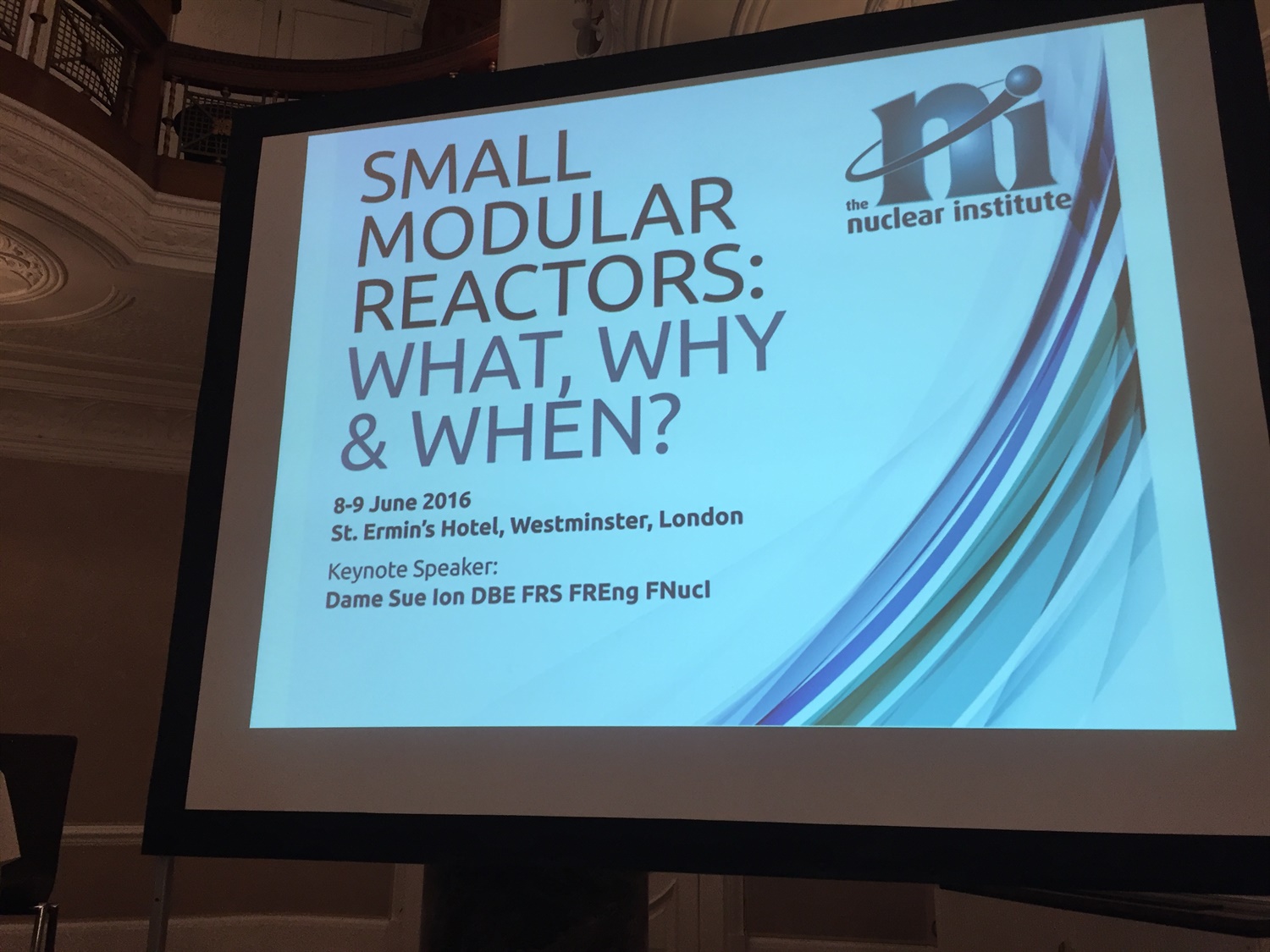By: Dr Rachel Odams-Roffe, ECITB
One of the most exciting developments over the last few years in the UK is the recognition by government and industry that new nuclear plants can form a major part of an affordable low carbon transition, with both large nuclear and small modular reactors (SMRs) potentially playing a role. The promise of affordable and deliverable SMR designs with an electrical generation capacity in units of 300 MWe or less opens up the potential to deploy a wider range of nuclear technologies within an integrated energy system. The potential for extended uses and benefits such as combined heat and power at an industrial level and the development of a UK based supply chain is equally exciting.
A fantastic step forward in understanding Small Modular Reactors.
The event builds on the 2014 summit and shows the growing momentum around SMRs.”
Professor Mike Tynan, CEO, NAMRC
SMR 2016 (June 8-9), hosted by the Nuclear Institute in London provided the perfect forum for this discussion to continue. Viewed from the perspective of delegates, speakers and panelists, the summit was a resounding success. The two-day event brought together leading figures in the industry representing the scientific and academic community, technology developers and vendors, manufacturers, contractors, operators and the regulator. The event programme covered all major issues associated with SMR deployment, technology and siting, as well as new insights and perspectives on the economic, regulatory, legal and policy context. Most importantly it enabled the industry to meet, discuss and debate issues and play a part in steering how SMR technology will be developed and ultimately deployed.
Event Chairs Professor Andrew Sherry and Dr Fiona Rayment from the National Nuclear Laboratory opened the event, providing industry and policy context and introducing speakers and the key topics that would be covered over the next two days. John Warden, Chief Executive of the Nuclear Institute welcomed delegates and thanked sponsors and supporters. John also provided background on the Institute’s involvement in the SMR debate and informed delegates of the forthcoming establishment of a new SMR special interest group within the Nuclear Institute dedicated to this important topic.
An exciting time for the industry
Keynote speaker Dame Sue Ion, Chair of NIRAB (Nuclear Innovation and Research Advisory Board) set the tone of the event in her presentation, which was both thought provoking and challenging.
According to Dame Sue the environment is favourable, but also increasingly complex. SMRs need to be part of a national inter-generational energy strategy that is linked to international nuclear developments. SMRs also need to be capable of meeting GenIV requirements, namely to be able to respond to the world's future energy needs, in particular the increased demand for electricity and reduced CO2 emissions.
Safety and affordability are clearly key requirements too; yet, Dame Sue believes there is also a dimension beyond the traditional energy trilemma of affordability, security and environmental considerations. In the case of nuclear, what do we want and which factor will be most significant? Is it cheap electricity, is it jobs, is it speed of connection to the grid, or maximum generating capacity? Each of these has different requirements and outcomes. Governments will have to decide which factor is most important when making decisions about energy policy and technology choices. Energy and industrial policy need to continue to be joined up in government, as she believes they are in nuclear. Industry and academia can and must be part of this and work with government to provide an evidence-based approach to support high-level ambition, and help engender confidence in an otherwise risk adverse environment.
Dame Sue believes that the UK has the best chance ever with SMR technology to enter the market and get there first. However, the window is “narrowing” and government may need to pick a winner to help develop the industry. We have “one shot to get slots and plots” in the UK, she says. The UK regulator cannot look at everything and decisions and choices will need to be made.
Yet, Dame Sue’s verdict is overwhelmingly positive, encouraging and realistic. The way forward for her is evidence based and that is the biggest contribution that bodies like NIRAB can play. Dame Sue is an influential figure within nuclear and her call to “sign up” to the industry, as it is, “one of the most optimistic times to be in the sector,” is a significant message.
Scope for industry confidence
Dame Sue’s optimism tinged with realism about timescale, cost and risk, was echoed throughout the two days in a series of engaging, frank and diverse presentations and discussions. Day One focused on the “why” and “what”, exploring industry dynamics and the types of technologies that are being developed. Day Two focused on “when” and explored the requirements that need to underpin industrialisation.
The context for development of SMRs is long-term energy security and the need for increased diversification of energy supply as the UK’s coal fired power station fleet is retired over the next decade. SMRs are seen as a potential complement to the UK’s current large-scale nuclear new build programme and there are some positive and encouraging signs from Government. Last year the Department for Energy and Climate Change (DECC) engaged Atkins-EY to undertake a Techno-Economic Assessment of Small Modular Reactors. Miranda Kirschel from Ernst and Young LLP spoke about this work, which is helping the government to build the case for SMRs. The report will be published later in the year. Mike Middleton from the Energy Technologies Institute (ETI) provided an overview of the extensive research and modelling work that the ETI is involved in to help government understand the market and potential contribution of SMRs within the low carbon energy mix.
Other developments were also announced last year, such as £250 million for R & D in the Chancellor’s Autumn Statement and in March this year DECC published the first phase of the UK SMR competition. The first phase aims to gauge market interest among technology developers, utilities, potential investors and funders in developing, commercialising and financing SMRs in the UK. In autumn DECC will publish an SMR roadmap which will summarise the evidence so far, set out the policy framework, and assess the potential for SMR development in the UK.

Pictured: Session One Panel (l-r) John Molyneux, Candida Whitmill, JaeJoo Ha, Miranda Kirschel, Mike Middleton
There are also international drivers, as set out by Dr Jaejoo Ha from the OECD, who reminded the audience of last year’s COP 21 Conference on climate change and the role that SMRs might play in a future low carbon world. The National Nuclear Laboratory forecasts 70GWe of electricity from SMRs, which is around 7-8% of the global picture, yet as Dr Ha explained there are many challenges that need to be addressed, such as licensing, financial risk, supply chain and market readiness. Whilst there are several international projects that are set to be operational by the mid 2020s, Dr Ha felt that a small prototype plant might be a way to provide the evidence of deployability in the UK.
The regulatory and licensing challenge was explored in depth on Day Two by Craig Reiersen and Ana Gomez Cobo from the Office for Nuclear Regulation (ONR). In an informative and refreshingly open presentation, Reiersen and Gomez Cobo explained current thinking and the stage of development of licensing for small reactors versus large power plants. Reiersen said it was “early days” and that they were in their infancy in thinking about SMRs, but that the ONR was committed to helping to “enable” the technology by recognising the different design and business case challenges. Professor Mike Tynan from the Nuclear Advanced Manufacturing Research Centre (NAMRC) welcomed the ONR’s contribution, saying that, “the fact that they stepped forward and provided substantial detail was valued by the industry.”
The SMR technology promise
The conference provided the audience with unparalleled insight into the leading technology platforms for small [and micro] modular reactors. The audience had the opportunity to hear from and discuss with business leaders from Westinghouse and Nuscale, two leading players in SMR technology, as well as U-battery and Moltex, representing micro-technologies at the
The presentations and panel debate threw up many interesting points about the state of readiness of the technologies for deployment, the financial and market challenges, as well as supply chain and public awareness issues. Amongst the positives are the safety case potential, scaleability, job creation potential, scope for UK industrial growth, supply chain development, commercial viability and export potential. In the case of micro technologies, co-generation, heat exchange and alternative uses, such as desalination were also highlighted. Each of the technology vendors believes they can develop electricity below the cost of large nuclear plants.
One of the take-away points from Day Two was about staying simple and avoiding unnecessary and costly complexity. Dr Tim Abram from Manchester University spoke about the need to “hold onto the idea of simplicity,” especially to meet the affordability criteria. This theme was reiterated by Adam Locke from Laing O’Rourke who spoke about “designing in” simplicity and “taking out” complexity from the outset of a project. Dr Giorgio Locatelli from Leeds University, highlighted “standardization,” as well as a long-term perspective as key elements for delivery success.
A second take-away and recurring theme on Day Two was the need to be realistic about timelines and manage what Professor Tynan describes as the interplay between “capability” and “capacity”. Tynan, who heads up the Nuclear AMRC, which is spearheading innovation in manufacturing techniques in this area, knows exactly what he means by this. He is positive about the UK’s potential and also our ability in the long-term to deliver the SMR agenda, but strikes a note of caution about managing expectations and the need to work progressively and be competitive on an international stage.
“We can manufacture Small Modular Reactors in the UK,” Tynan says, including all parts of the module, and, “we can develop the capability and capacity in the UK, but we have to be paced. We need to think about getting ready.”
This means close monitoring of developments and “maintaining the momentum,” and setting realistic timescales and expectations for supply chain development.
This note of caution was echoed by Ian Truman from Burges Salmon LLP. Truman as a former member of the Hinkley C legal team working with EDF Energy knows the ins and outs and what the industry should be aware of and reminded the audience that there are still legal hurdles to overcome before full deployment is possible.
The theme of “getting ready” was also clear in Rolls Royce’s presentation by John Molyneux, which was a comprehensive sweep through time using examples from nuclear submarines and civil aerospace industries, through to current nuclear programmes to show how technologies evolve, change and develop and what interdependencies are needed to achieve a successful breakthrough.
Conclusions
No one believes that the roadmap is completed yet. There is still a long way to go. Future development depends on certainty around energy policy, especially for investors, the licensing framework and market conditions, amongst other areas. There is also an unanswered question around using up plutonium stocks and whether the government will push for this. Dr Rayment summed it up as the still open ended question of “what does the UK want?” and how it intends to balance the needs of the energy quadrillema.
Still there is no doubt that the event was an important step forward in the SMR debate. It brought together a broad range of stakeholders and created a space to engage in an open and frank debate about SMRs and what is required now to develop the technology and business case, and to shape policy and move towards deployment. Co-chair Professor Sherry said the event had, “a different feel…a sense of reality and anticipation,” and was, “very timely and showed a depth of thought and challenge.”
|
Key Conference Findings
|
- What do we want from Small Modular Reactors?
- What should be our policy objectives? What are our success criteria?
- Importance of industry engagement
- Need for long-term strategies
- Importance of resolving funding, licensing and siting issues
- Addressing high capital costs
- ONR – SMR specific issues. Commitment to flexibility and enabling
- Site assessments need to be looked at again
- Public engagement
- LCOE – driving down costs
- Keeping it simple, design simplicity, standardisation, innovation
- Supply chain development
- Is the UK enough to achieve the required economies of scale?
- Global market is needed to make SMRs viable
- Window of opportunity in the UK with a receptive and committed government
|